Croatia’s cuisine has many influences, thanks to its central position in Europe. The Mediterranean is one, apparent in the use of tomatoes, eggplants, bell peppers, herbs, olive oil, and abundant seafood.
Some of the meatier dishes are a legacy of the central European countries that lie to the east of Croatia. Italy, just across the Adriatic, has brought pasta and risotto to the table, while the grape varieties that produce Croatia’s award-winning wines can also be found in Austria, Italy, France, and Greece.
You can dine well in Croatia in relatively simple, unpretentious establishments, called konoba. Because there’s so much emphasis on local, seasonal ingredients, the best dishes are often the most uncomplicated—a fresh fish drizzled with local olive oil and scattered with herbs, for example, or mussels in a white wine broth, or pasta sprinkled with grated truffle.
Here are some of the finest examples of Croatian cuisine.
Fuži (Pasta)

Fuži
Pasta is very popular in Croatia thanks to the influence of nearby Italy. However, Croatians have their own names and shapes and use sauces that make the most of their own fresh ingredients.
Making fuži is a laborious task, as the pieces of pasta dough are wrapped around the handle of a wooden spoon to shape them. The pasta is served with a creamy, heavily truffled sauce, or sometimes with a meatier version, made from whatever is available, such as beef, chicken, or even game.
Buzara
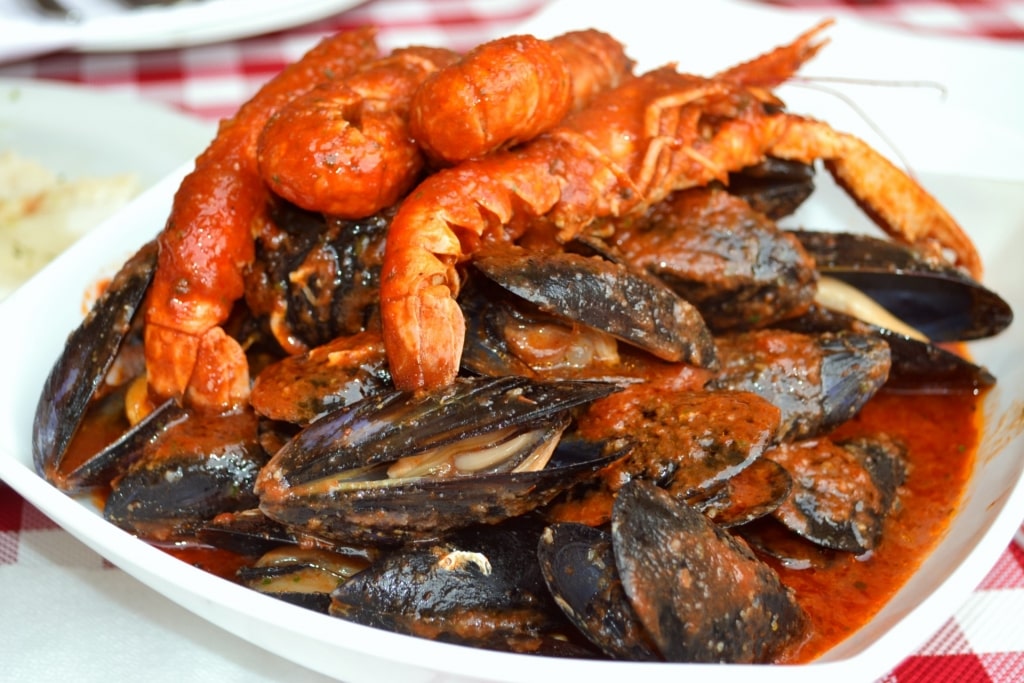
Buzara
Buzara is a simple but delicious dish similar to the French moules marinière. Mussels are stewed in a wine-based broth with garlic, fresh herbs, and breadcrumbs. You’ll find buzara all along the coast, where the mussels will have been harvested that same day.
Crni Rižot (Risotto)

Crni rižot
Squid ink risotto features on pretty well every menu along the coast and is one of Croatia’s most famous dishes. This rich risotto is packed with squid and sometimes other seafood, its black color and intense flavor coming from the squid ink.
Be warned: although the taste is delicious, this popular European food can temporarily turn your teeth and tongue an alarming shade of black, so drink lots of water (or wine) and don’t pose for photos over your meal until you’ve checked in a mirror.
Njoki (Gnocchi)
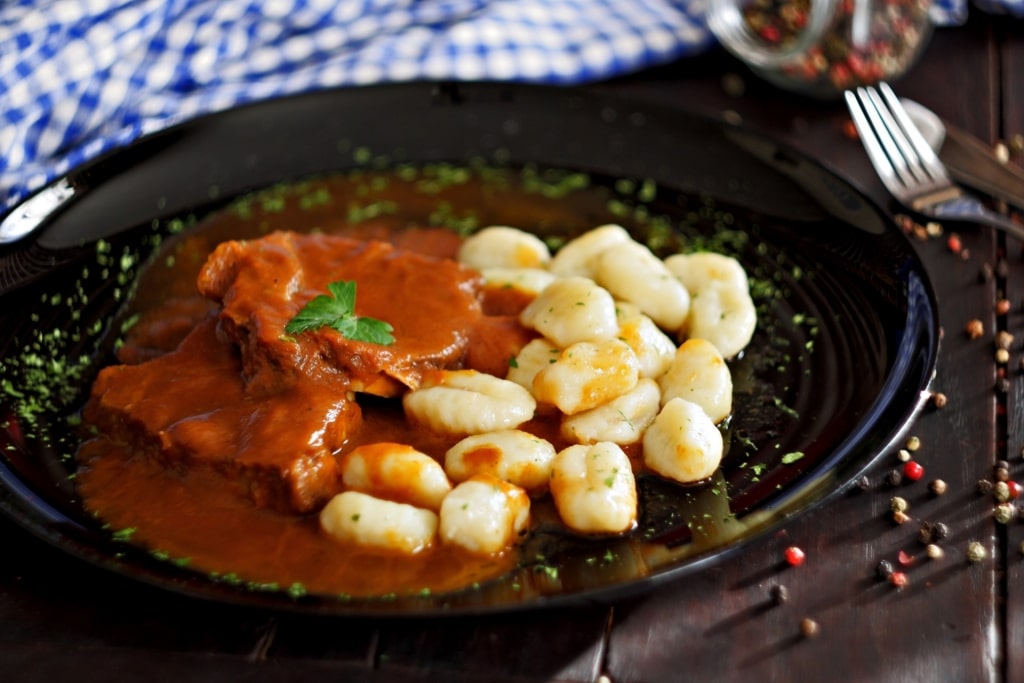
Njoki
Try to pronounce njoki and you’ll realize what it is: gnocchi, similar to what you’d be offered in Italy. Njoki is a comforting dish of small potato dumplings that also include semolina and egg.
They’re normally served as a side to pašticada, a rich, beefy stew, but also make a great vegetarian dish with melted butter, fresh sage, and a sprinkling of grated cheese, or even truffle.
Pag Cheese
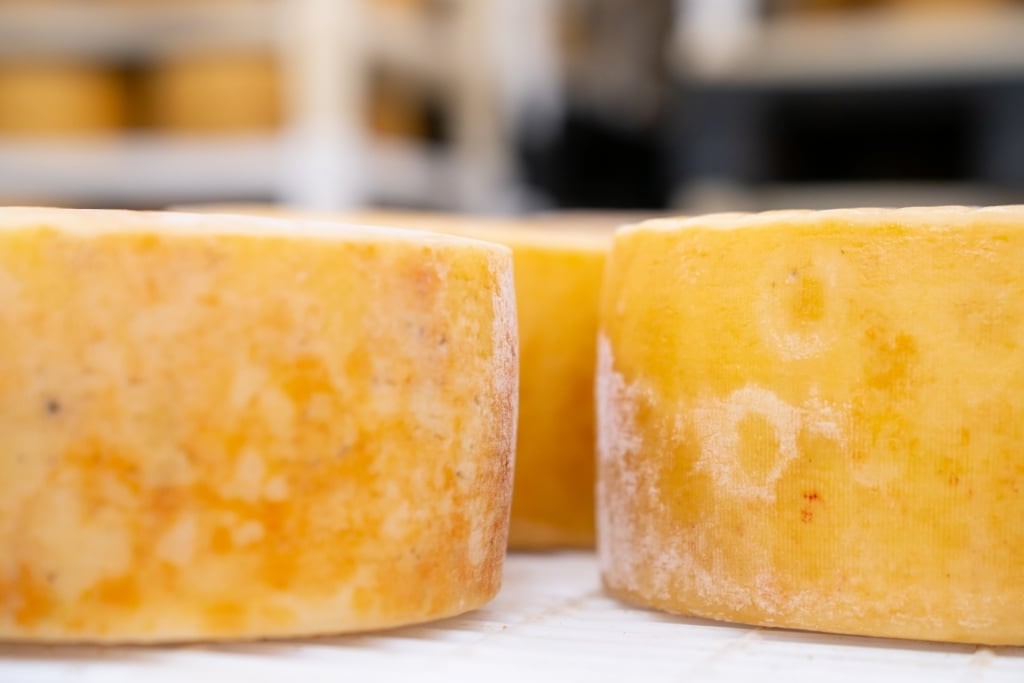
Pag cheese
Pag is a salty sheep’s milk cheese from the eponymous island in northern Croatia, near Zadar, where there are many more sheep than humans. The sheep feed on wild herbs imbued with a faint tang of salt, thanks to the strong Bura wind that gusts across the sea in winter.
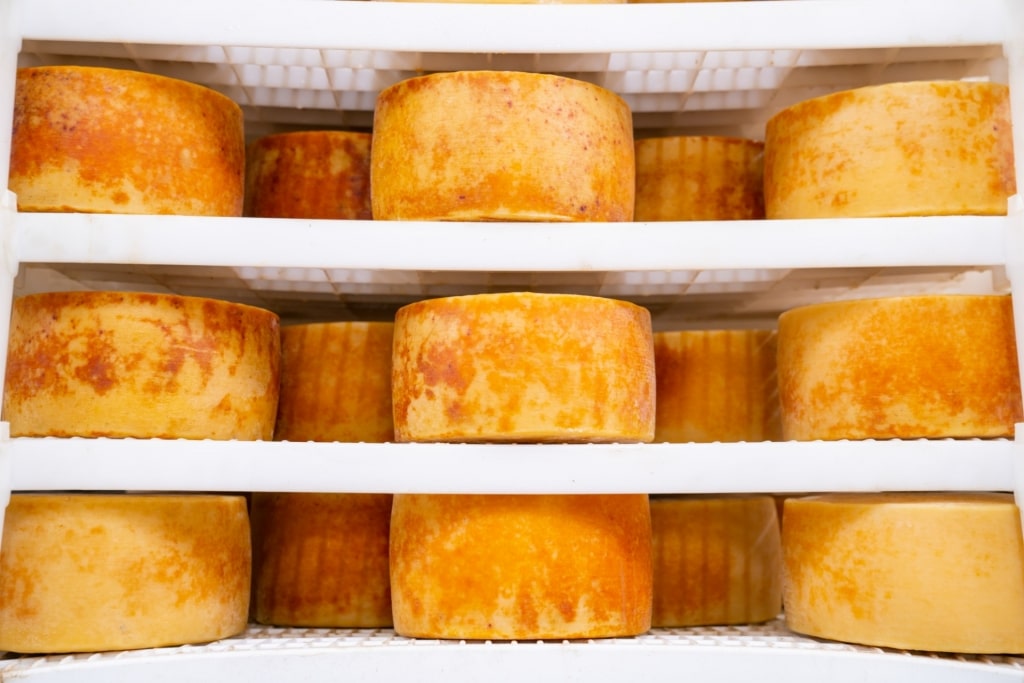
Pag cheese
You’ll see big wheels of pag in markets and in specialty cheese shops. Croatia’s answer to parmesan, aged pag is crumbly and has an intense flavor that comes from a long maturation of up to 18 months.
Younger cheese bears more resemblance to the creamy manchego from Spain. Either way, enjoy it grated over pasta and risotto dishes, or just on its own with a little olive oil.
Olive Oil
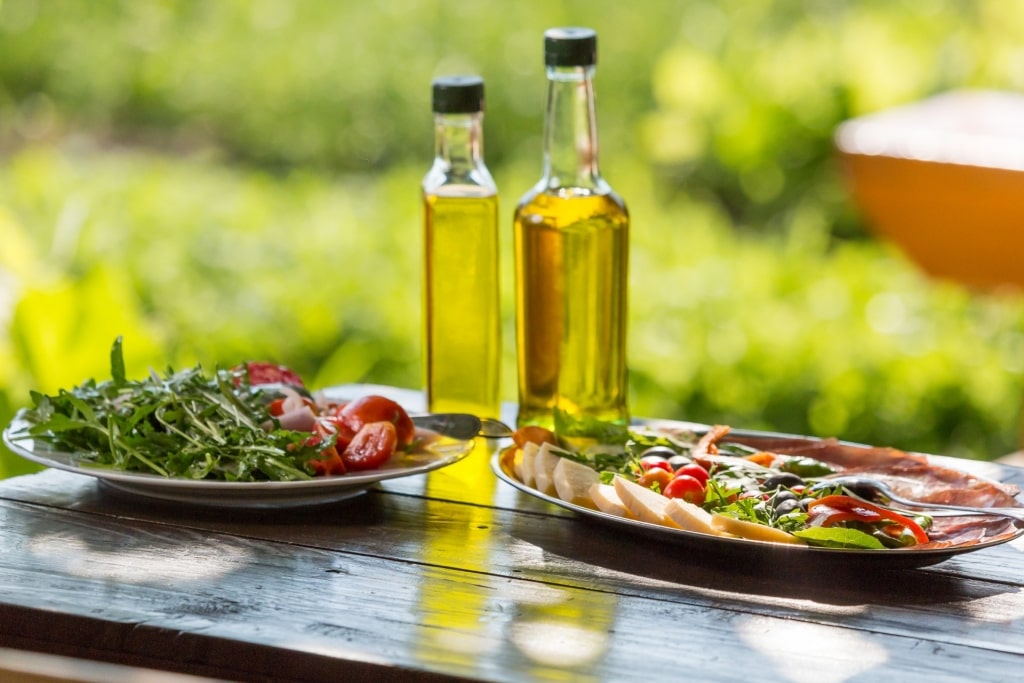
Olive oil
Olive trees have been cultivated in what’s now Croatia for 2,000 years, and the locals have refined olive oil production into a fine art, winning many international awards in the process.
Olive oil is used extensively in cooking and as a salad dressing, of course, but the best way to taste it is neat. Pour some onto a plate and dunk crusty bread in it to absorb that quintessentially Mediterranean flavor. A bottle of EVOO (extra virgin olive oil) from Istria makes a great gift to take home, too.
Soparnik
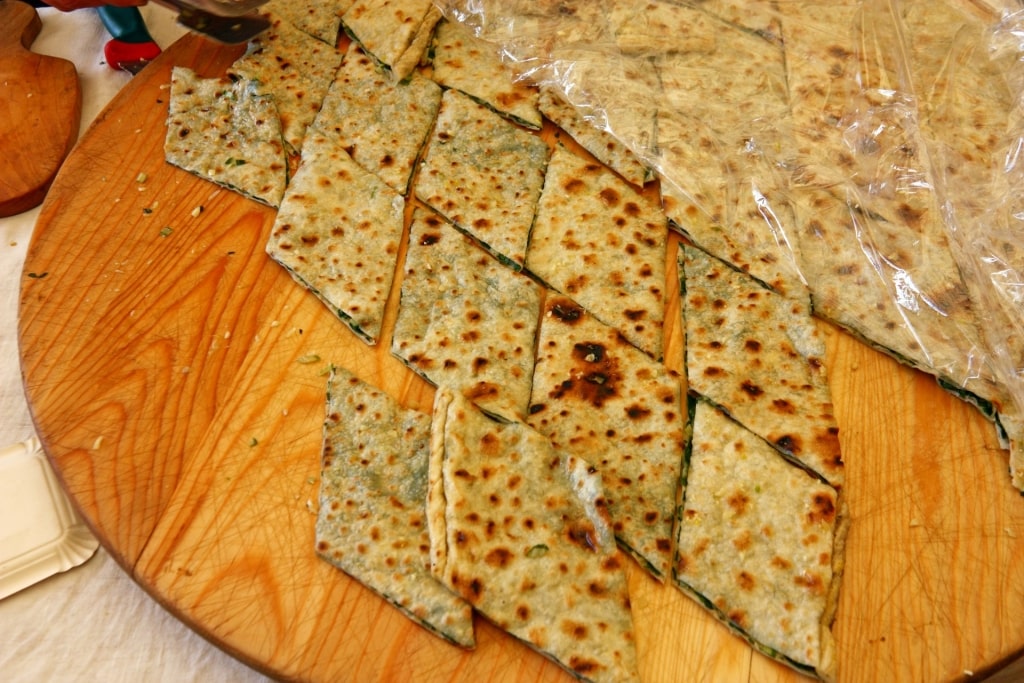
Soparnik
A delicious option for vegetarians, soparnik is a Croatian classic; a thin pastry pie filled with Swiss chard. Some even believe it to be the predecessor of the Italian pizza.
You’ll see soparnik for sale in markets, prepared fresh in one giant, circular pie that’s sliced up when cooked. The filling is simple: olive oil, fresh parsley, scallions, garlic, and chard, but the end result is extremely delicious.
Oysters

Oysters
In the coastal town of Mali Ston, just over an hour from Dubrovnik, oysters are farmed and appear everywhere: on menus, in bars, and on stalls at the side of the road.
There’s even an annual oyster festival here, in March. Ston oysters are known for their intense flavor, and locals regard themselves as connoisseurs.

Ston
If you’re a fan, the trip from Dubrovnik is worth it. Ston is something of an unsung hero in Croatia, but it’s an intriguing little town, defended by more than four miles of chunky ramparts dating back to the 14th century and snaking over the hillside.
You’ll find plenty of unassuming local restaurants here where you can kick off lunch with a vast platter of freshly harvested Ston oysters.
Kulen Sausage
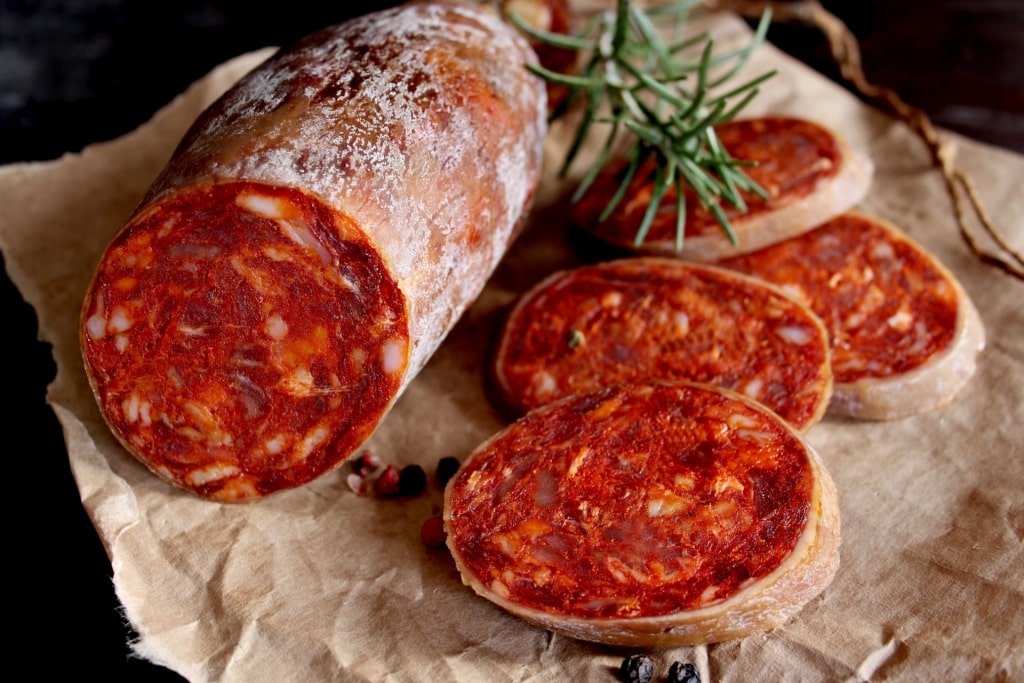
Kulen sausage
Croatians love their cured meats, and kulen is the country’s most prized sausage. It comes from valuable Mangalica pigs raised in Slavonia, in the east of the country, free ranging in the forest on a diet of acorns and barley.
The sausage is smoked over beechwood and then air dried, maturing for nine months, hence its status as a delicacy. All that’s added is salt, paprika, and garlic. Eat kulen with crusty bread and crisp white wine or a light red.
Ćevapi

Ćevapi
A classic all over the Balkans, ćevapi is a meatball shaped like a stumpy cigar made from minced meat—beef, mutton or lamb—and seasoned with chopped onion, garlic, and fresh parsley.
The patties are served on flatbreads with ajvar, a delicious condiment made of roasted bell peppers and eggplant, with lots of olive oil and a dollop of soured cream.
Fritule

Fritule
Served at Christmas but often available outside the festive season, fritule are tasty little doughnut balls, deep fried and dusted with powdered sugar. Bite into one and the taste of rum and raisins will flood your mouth.
Some cooks add lemon or orange zest to their fritule. Others up the decadence by dunking the doughnuts in melted chocolate or caramel.
Brudet (Seafood Stew)

Brudet
Sometimes called brodetto, this simple but tasty seafood stew actually comes from neighboring Italy, where it’s been a traditional dish cooked by fishermen using offcuts from the day’s catch.
Essentially, brudet is a rich tomato base flavored with fish stock, herbs like bay leaves and rosemary, wine, and vinegar (traditionally used as a preservative), with whatever seafood is on hand to throw in.

Brudet
Mussels, shrimps, squid, and clams are all fair game, as are chunks of firm fish, left on the bone. The stew isn’t stirred, which would break up the fish. Instead, a good brudet cook will simply swirl the pot to agitate the ingredients. Mop up the delicious sauce with fresh bread.
Pršut (Air-Dried Ham)

Pršut
Air-dried ham from Istria, or pršut (in Italian, this would be prosciutto), is ubiquitous in Croatia. A mouthful invokes the flavor of wild mountain herbs and the winter Bura winds in which it’s hung.

Pršut
You’ll find platters of pršit i sir—ham and cheese—on every menu, and there’s no better way to eat lunch in the sun than to sit down with this feast in front of you, along with some crusty bread and a bottle of chilled graševina white.
In the south, ham is smoked rather than air-dried, so has a different but equally delicious flavor.
Punjena Paprika
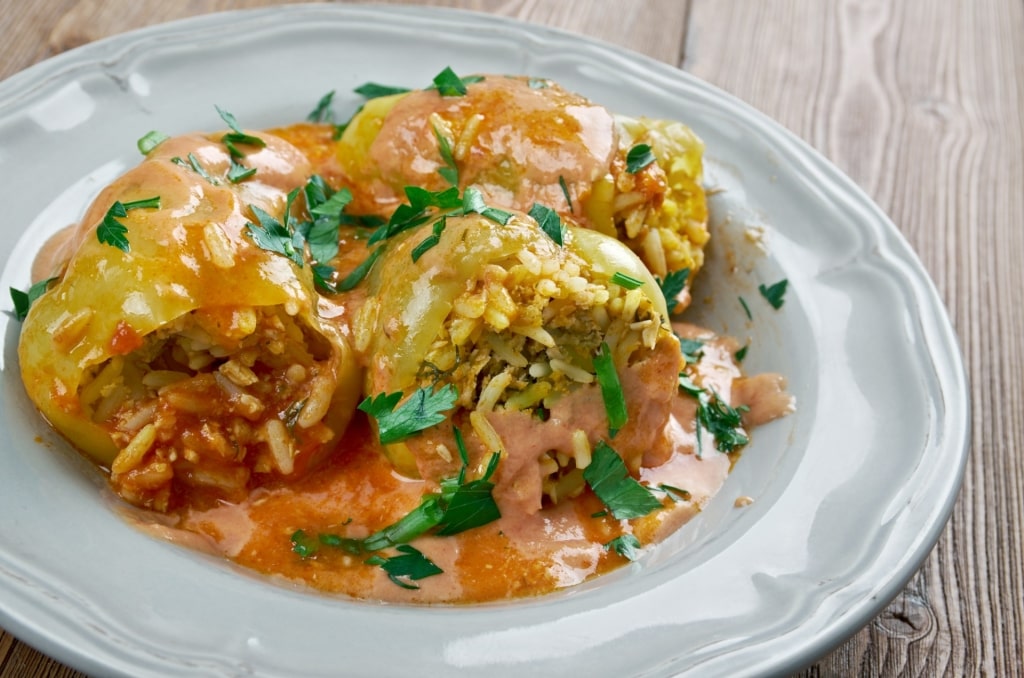
Punjena paprika
Popular all over the Balkans and south into Greece, stuffed bell peppers are a Croatian summer classic. Bell peppers in different colors are hollowed out and stuffed with a mix of rice, spiced meat, eggs, herbs, and spices, then baked in a tomato sauce in the oven, and served with a side of mashed potato.
Read: Best Summer Destinations in Europe
Burek

Burek
Layers of flaky pastry filled with cheese, meat, or for a sweet version, apple, burek pies can be anything from a mid-morning snack to a savior for hungry vegetarians; rich as its cuisine is, Croatia isn’t the most veggie-friendly country.
Look for a cheese and spinach filling, too, which is a marginally more nutritious version of this delicious and calorific snack.
Rošata

Rošata
This wobbly, creamy custard pudding is Croatia’s version of crème caramel. What’s different is that the flavoring comes from rose liqueur, or in some restaurants, maraschino cherry liqueur.
Bučnica (Savory Strudel)

Bučnica
Another great Croatian food for vegetarians to try, Bučinca is a savory strudel. Sour cream, butter, eggs, cottage cheese, and pumpkin are wrapped in phyllo pastry and baked. To Croatians, bučinca is a popular comfort food.
Savijača (Sweet Strudel)

Savijača
Croatians love their strudel, and savijača is a sweet version. Layered phyllo pastry is baked with cheese and a filling of apple or sour cherry (or in season, apricots), dusted with powdered sugar, and served with cream or a scoop of ice cream.
Sarma
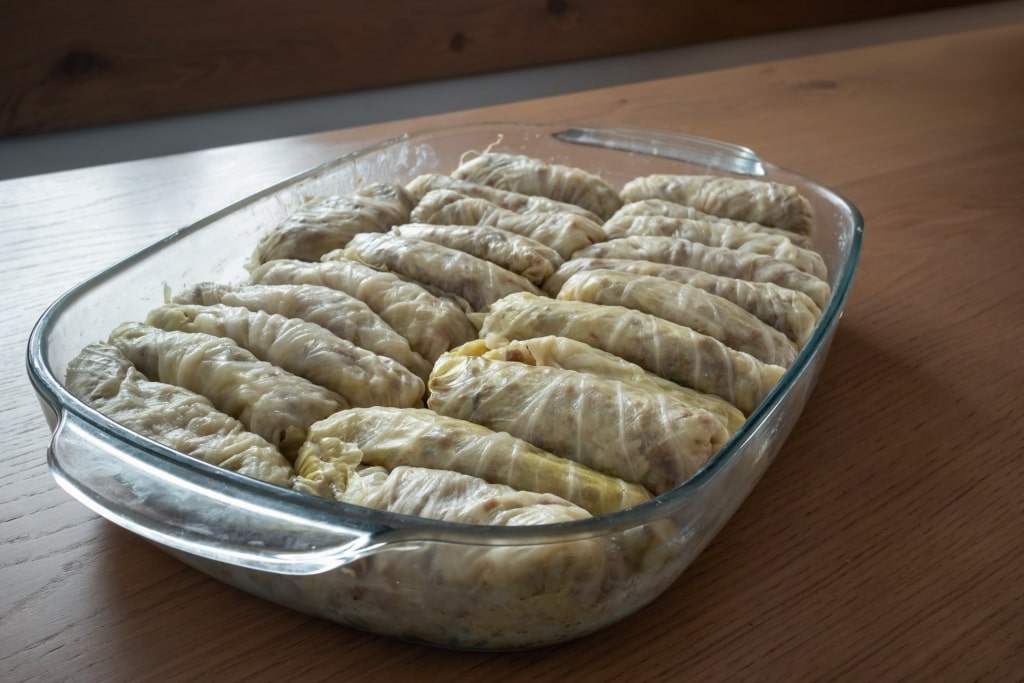
Sarma
You’ll find variations of these cabbage rolls all over the Balkans; in Greece, the filling is wrapped in vine leaves and the dish is called dolmades. In Croatia, though, sarma is made of spiced minced meat and rice wrapped in sauerkraut, a legacy of the country’s proximity to central Europe, where cabbage is popular.
The meat could be pork, beef, or both, flavored with paprika and smoked bacon. The little parcels are slow-cooked in water and served with mashed potato and a dollop of crème fraiche.
Maneštra

Maneštra
Maneštra is not dissimilar to Italy’s minestrone soup. Lighter versions, made with dried beans, carrots, celery, onion, and tomato, seasoned with black pepper and fresh parsley, may be served as a starter.
With the addition of pork ribs and sweetcorn, you’ve got a much heartier main course, popular as a winter warmer but available on menus year-round.
Zagrebački Odrezak (Schnitzel)

Zagrebački odrezak
If you’ve traveled to Austria, you’ve no doubt tried Wiener Schnitzel, thinly beaten veal coated with breadcrumbs and fried. Zagrebački odrezak is Croatia’s version.
The veal is tenderized and rolled around cooked ham and cheese before being dipped in beaten egg, coated in breadcrumbs, and fried. You may see chicken or pork versions on menus as well as veal.
The schnitzel is served with a side of fries, sometimes risotto, green peas, and a squeeze of fresh lemon.
Pinca
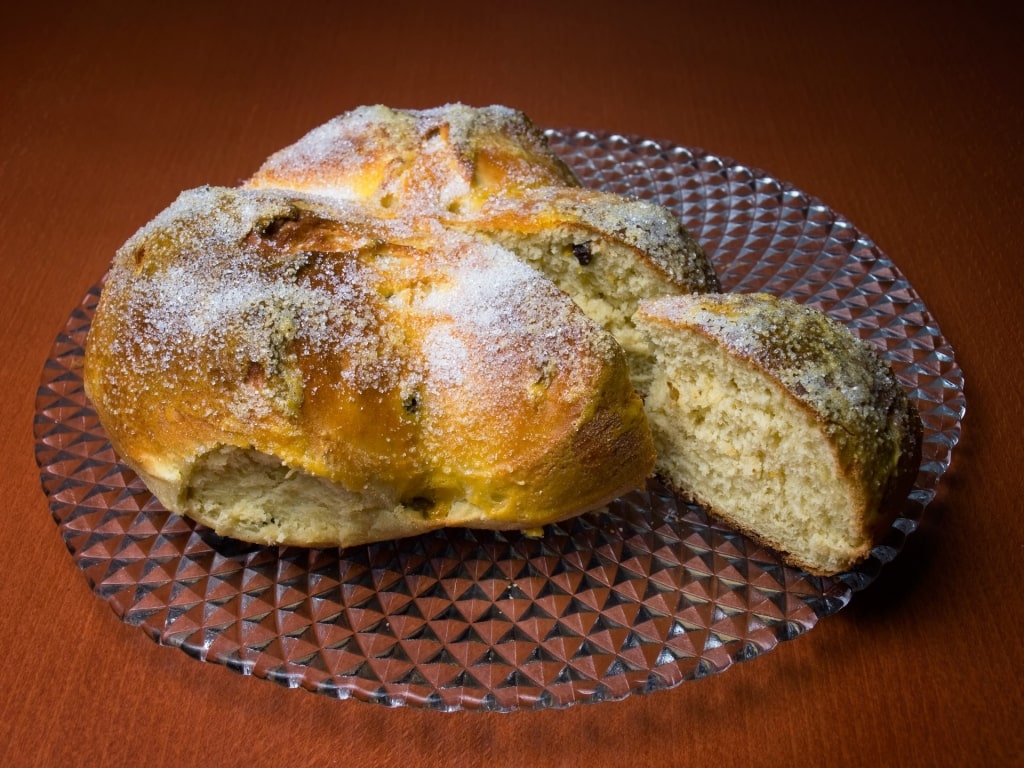
Pinca
A sugary sweet roll, pinca is an essential addition to the table at Easter, an important festival on the Croatian calendar. A rich yeast dough is combined with all manner of ingredients, from citrus zest to dried fruit, rum, and dessert wine, and then shaped into a loaf shape and sprinkled with sugar and chopped nuts before baking.
Truffles
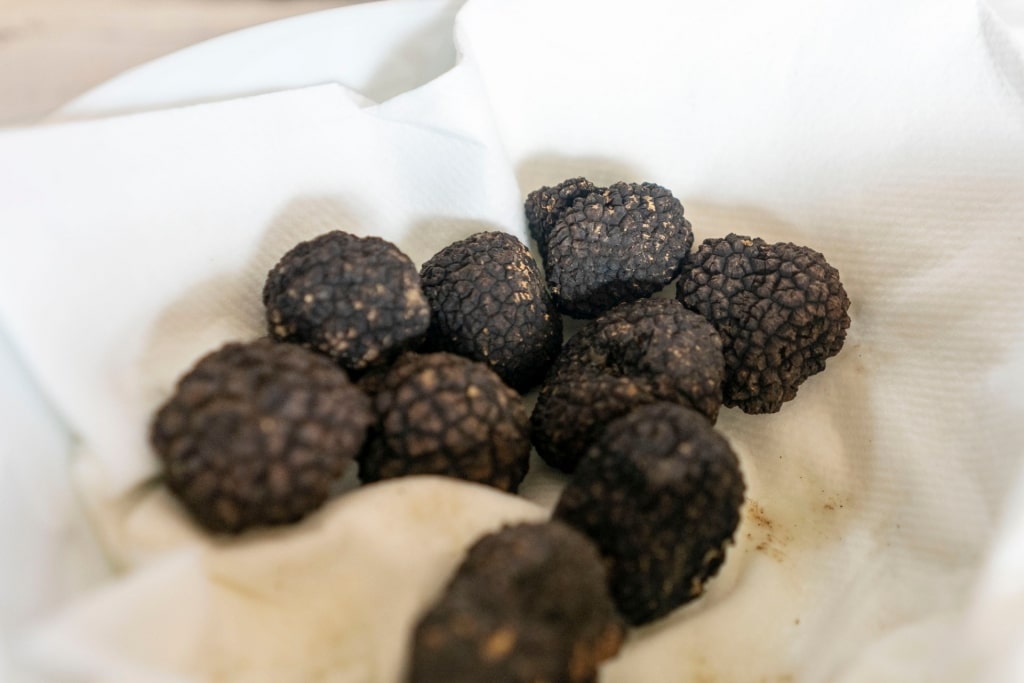
Truffles
In Croatia, truffles are harvested in Istria, to the north, usually around October. While you may not be around for the harvest season, you’ll find truffle shavings grated over several dishes, from pasta to risotto or even omelets. You can buy them dried as a souvenir, too, to bring back memories of those sunny days along the Adriatic coast.
Wine
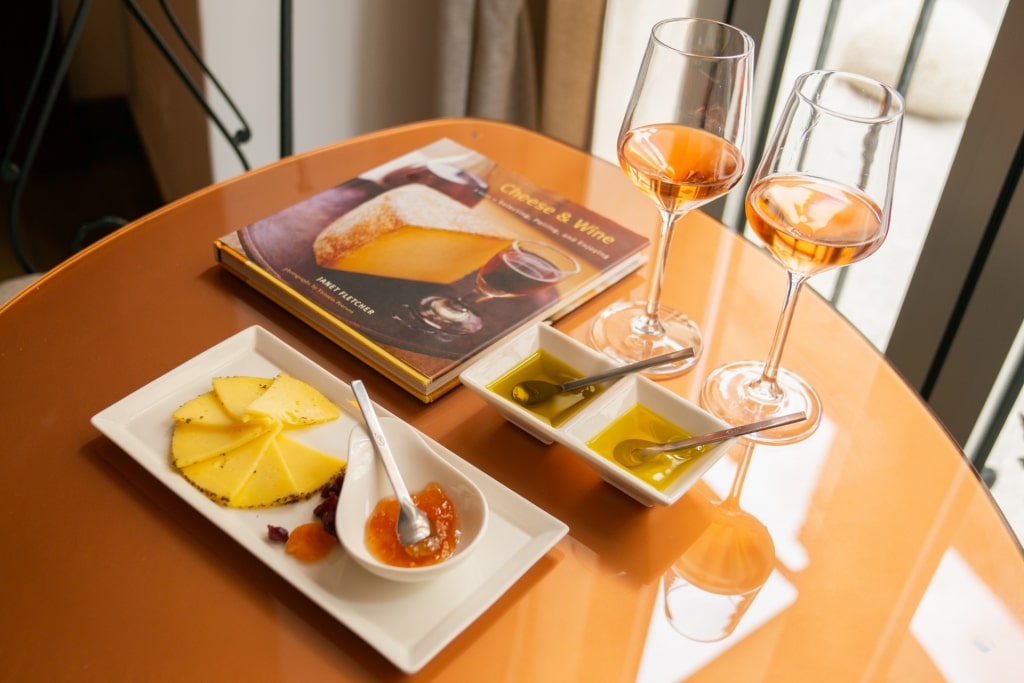
Croatian wine
Croatia is known for producing spectacular wines, with some boutique wineries practicing biodynamic and organic production. Many of the better wines are kept for domestic production, which is why you may not be familiar with them at home.
The most common white is malvazija, with notes of apricot and apple and a crisp minerality. This is an easy drinking wine, best enjoyed with seafood, as an aperitif before lunch, or when taking in a gorgeous sunset. Along the Dalmatian coast, you’ll find graševina on every menu, which is a dry, aromatic white.
Croatia’s most popular red is teran, robust and flavor-packed, typically consumed with meat dishes and pasta.
Read: Romantic Places to See on a Honeymoon in Croatia
Rakija
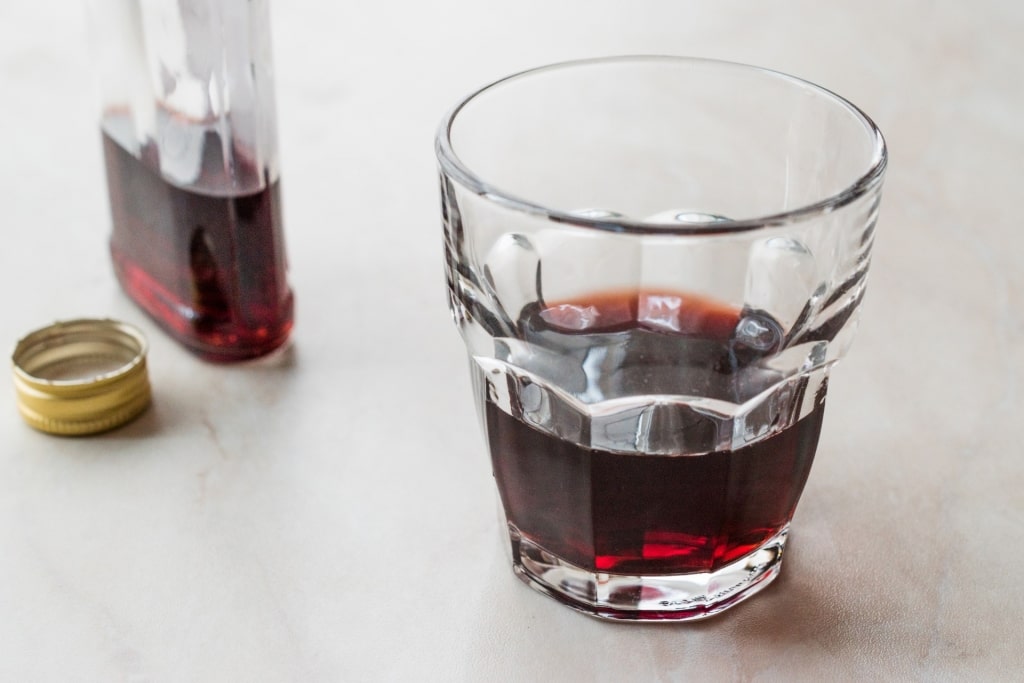
Rakija
Rakija is a distilled fruit spirit commonly drunk after a meal as a digestif. Often, the proprietor of a konuba will bring you a shot as a gesture of hospitality.
Rakija comes in various flavors. Perhaps the most familiar is šljivovica, or plum, but you could be offered variations flavored with honey, sour cherry, or fig.
The etiquette for rakija consumption is to raise your glass, make eye contact with your companions, clink, and down the fiery shot in one.
Pašticada
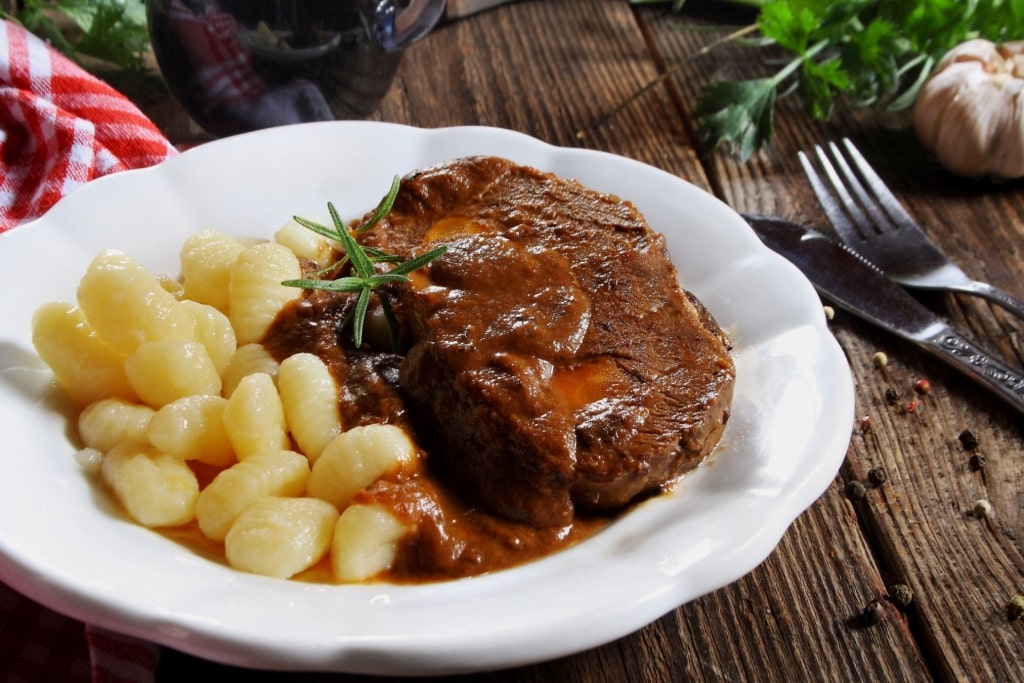
Pašticada
A traditional Dalmatian stew made with beef, prunes, and red wine, Pašticada takes two days to cook. It starts with a large joint of beef that’s stuffed with bacon, cloves, and garlic.
The meat is then marinated in vinegar, herbs, and spices for up to a day before slow-cooking in a rich broth with carrots. While different recipes add their own variations, such as tomatoes, the traditional base is prunes, sweet Prošek wine, parsley root, and bay leaf.
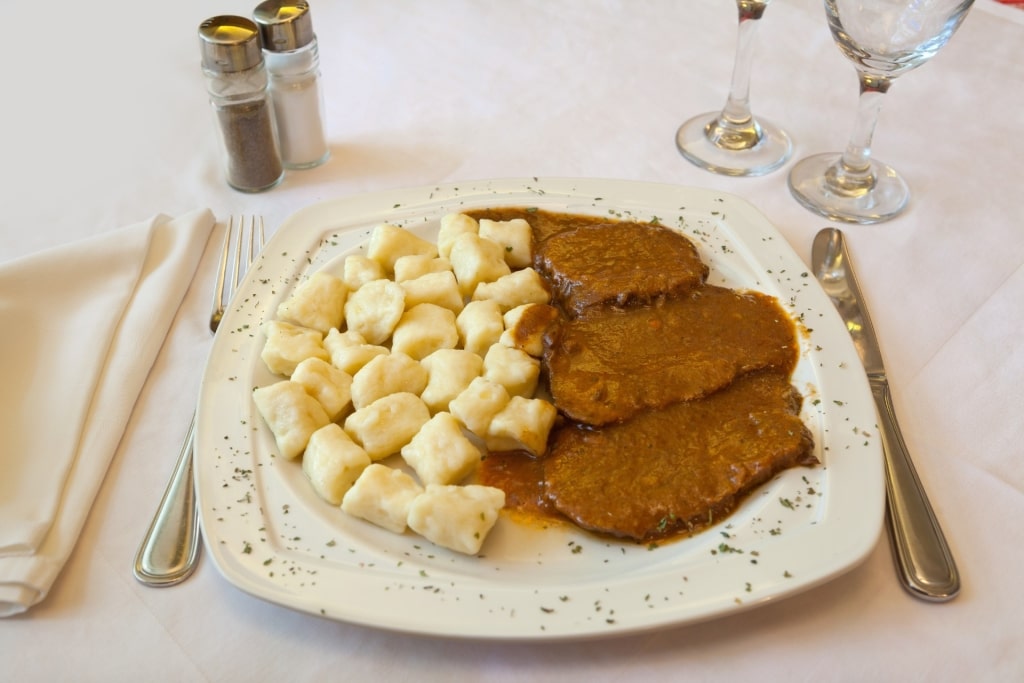
Pašticada
After all this, the meat is beautifully tender but the time required does mean the dish is usually reserved for weddings and other major celebrations. With its rich sweet and sour tang, it’s perfectly accompanied by homemade pasta or gnocchi.
The use of wine and vinegar to marinate tougher joints of meat has roots in Venetian cuisine, where it was used in a traditional horsemeat stew. Hungarian goulash also seems like a close cousin to Pašticada.
Peka

Peka
The name “Peka” refers to a cooking method where a covered cast iron pot is buried in hot coals. While a modern version now exists, traditionalists still swear by the old method.
The contents of the pot might be lamb, veal, or octopus—known as “Ispod Peke”—along with potatoes and vegetables. Broth is added before the long cooking process steams everything into a tender stew.
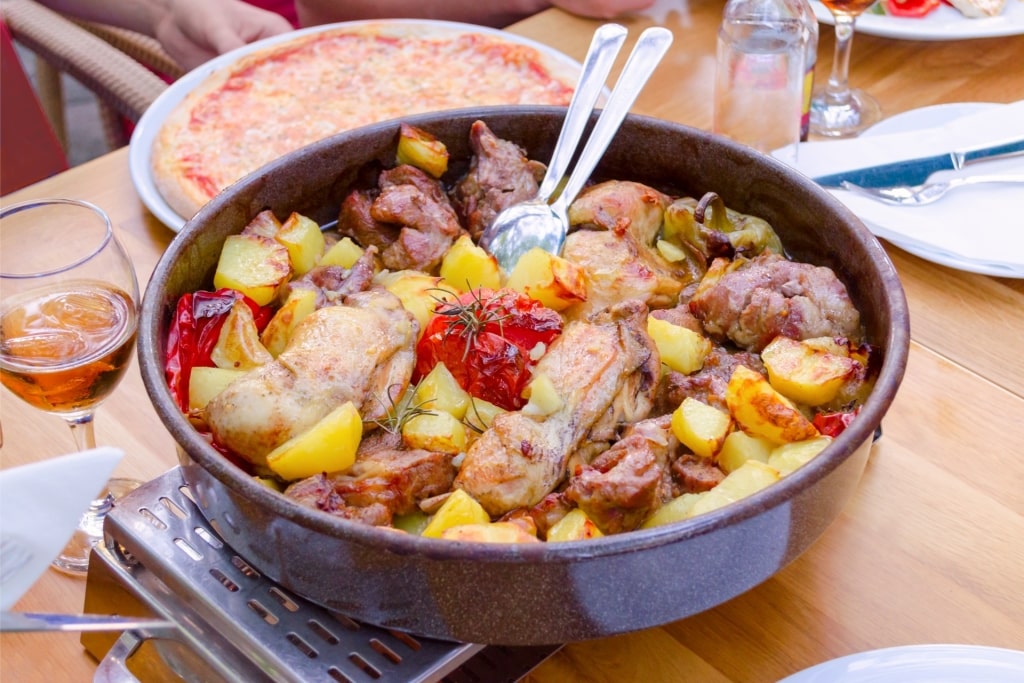
Peka
Peka is thought to be among the oldest foods in Croatia, as pots dating to around 800 BCE have been excavated in the region. It was a useful method when farmers or fisherfolk were out all day but could return home to a hot meal.
Taking several hours to cook, the meal is reserved for special occasions or as an advance order in restaurants. It’s usually served with a seasonal salad and crisp fresh bread to soak up the juices.
Read: Most Beautiful Places in Croatia
Janjetina na Ražnju

Janjetina na Ražnju
Spit-roast a whole lamb over an open fire and you have Janjetina na Ražnju. This classic dish from the Croatian mountains is often part of a social event, made for large family or village events.
The lamb has to be turned by hand for hours and constantly basted. A mix of salt, herbs, water, and fats keeps the skin crispy and the meat juicy.
The roots of the dish lie in the tradition of roasting a spring lamb for Easter. It’s eaten communally and a key part of any conversation, usually among the men in the party, will be about the right wood to use for the fire.
Gregada
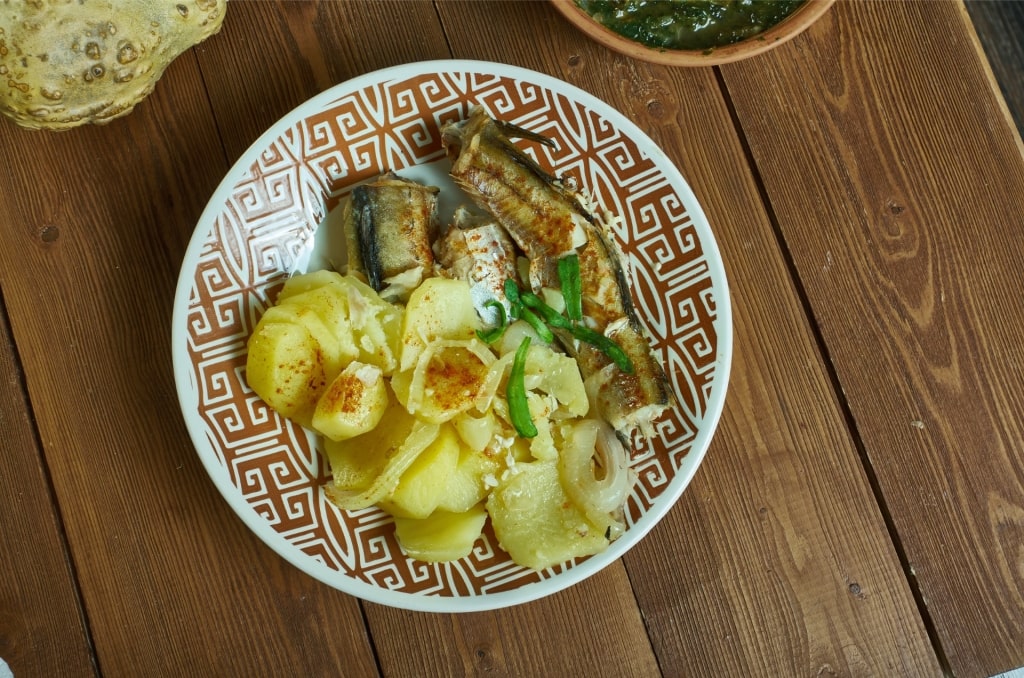
Gregada
This fish stew from the island of Hvar is famous for its unique taste. Using large pieces of fish, along with potato, onion, garlic, and white wine, it also makes liberal use of parsley.
Gregada is not boiled but baked in the oven, creating a more complex taste range. It shouldn’t be stirred, as that will break up the fish.
Copies of the recipe have been found in records dating back five centuries. Every family in Hvar has its own, no doubt most authentic version of this prized Croatian food.
Key to any recipe is the use of the freshest fish, preferably firm-fleshed white ones such as sea bass or red mullet. To that non-negotiable base, you can find extras added such as prawns, langoustines, or anchovies.
Bakalar na Bijelo
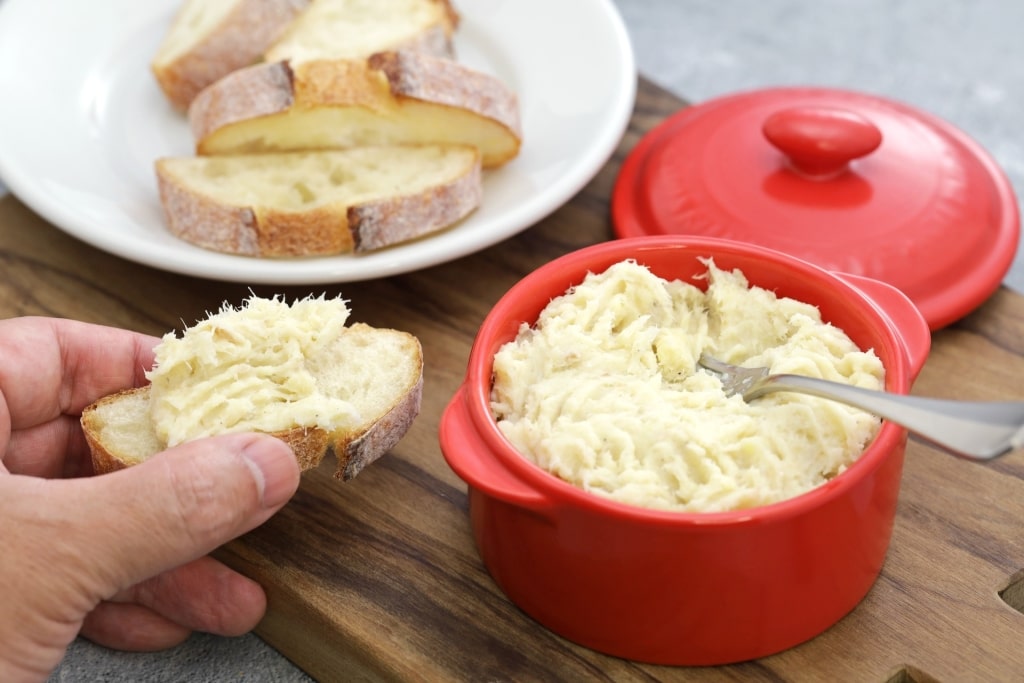
Bakalar na Bijelo
This creamy white spread is made from dried salt cod, or Bakalar, more familiar as the Portuguese Bacalhau or saltfish. The fish is first soaked for days to remove the salt, then boiled and mashed with olive oil.
The addition of garlic and parsley adds flavor, while some cream might be used to lighten it. It should have a consistency very like a mousse.
The dish is a tradition all along the Croatian coastline for Christmas Eve. This has its roots in the Catholic practice of eating fish for both Christmas Eve and Easter.
If the fish taste is too strong, you can find versions with potato added. Bakalar is served warm with polenta or bread and also goes well with a glass of Croatian wine.
Blitva s Krumpirom
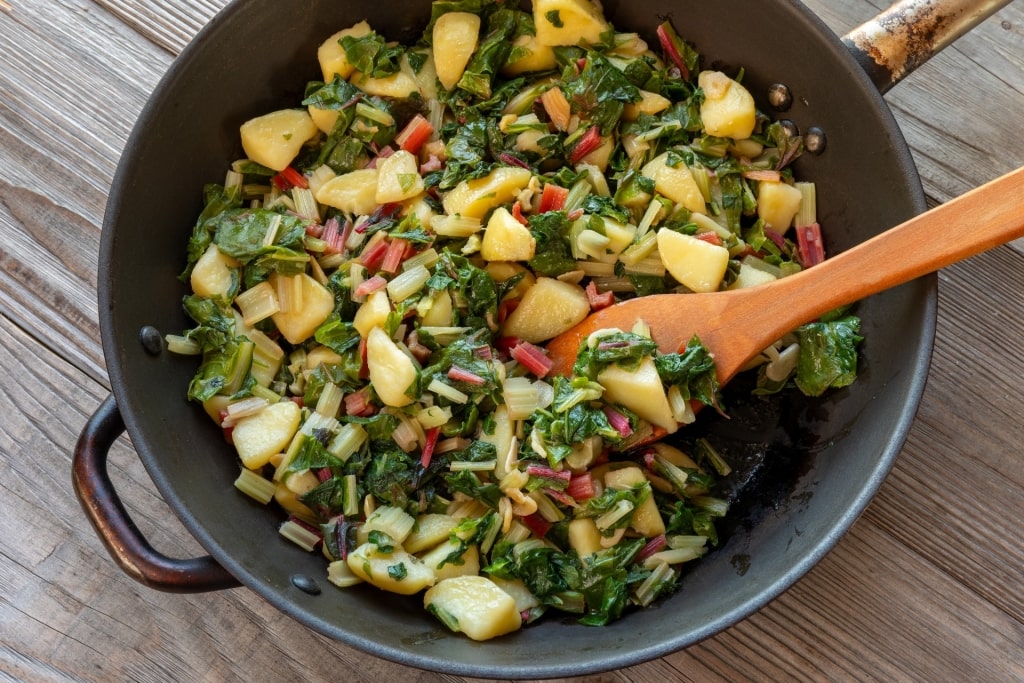
Blitva s Krumpirom
This simple side dish of Swiss chard—“Blitva”—and potatoes—“Krumpir”—is served with main courses such as grilled fish. The chopped vegetables are boiled, then sautéed in lots of garlic and olive oil.
Although it sounds simple, it’s delicious when prepared well with good ingredients. It’s a classic of Croatia’s healthy Mediterranean diet, low in calories and high in vitamins.
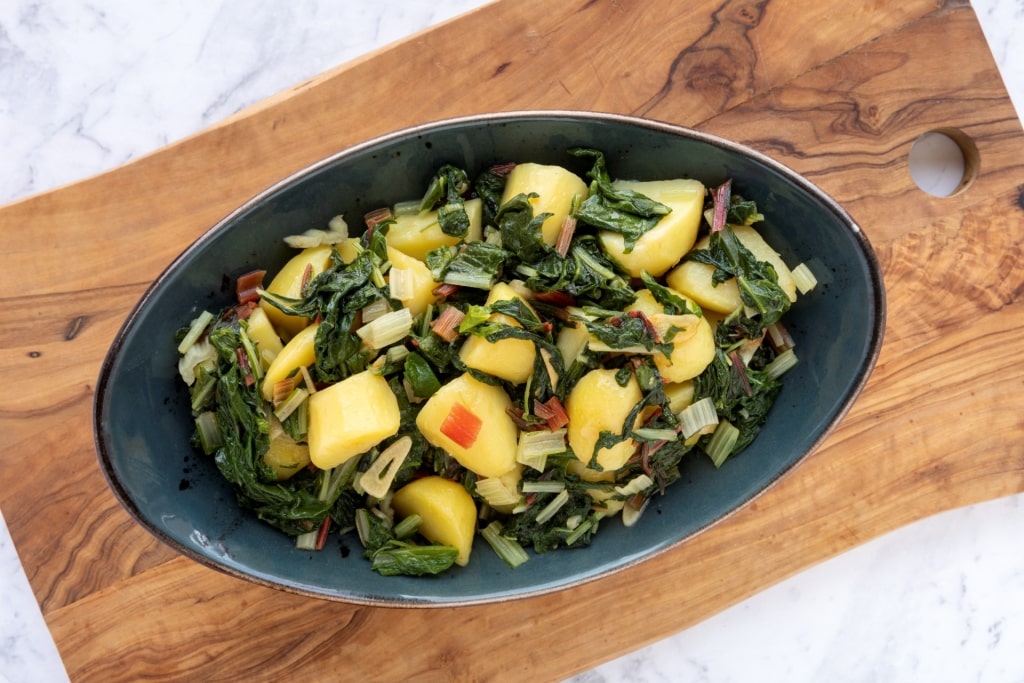
Blitva s Krumpirom
Blitva, as it’s usually called for simplicity, can be seen on any restaurant menu. Such a plain dish seems to beg chefs for intervention and you’ll find additions such as garlic, parsley, or even bacon.
A more traditional extra is a splash of white wine, especially in coastal regions. Some family recipes also add lemon juice or cheese.
Štrukli
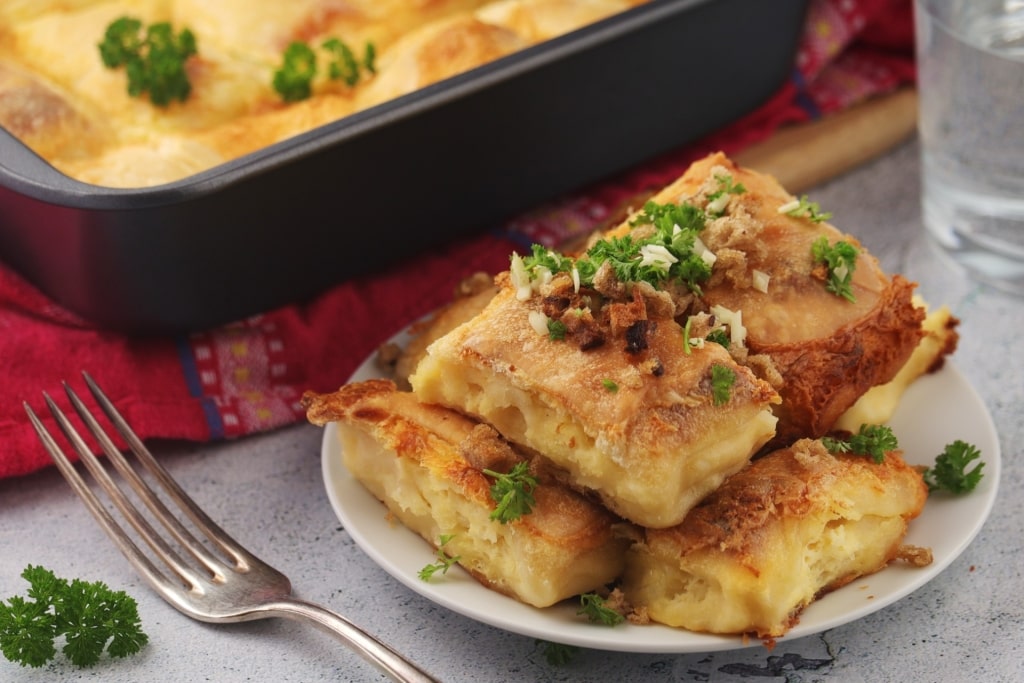
Štrukli
This comfort food from the Zagreb region is considered a national dish of central Croatia. It’s a pastry made with thin dough and a filling of fresh cheese, eggs, and sour cream.
Štrukli can be baked or boiled like a dumpling, and served as a main dish or even as a dessert. Golden from the oven, they make a rich, creamy, lasagne-like casserole, while the boiled version is softer and often served in broth.
There is great skill involved in making the dough thin yet strong. It’s said you should be able to read a newspaper through it.
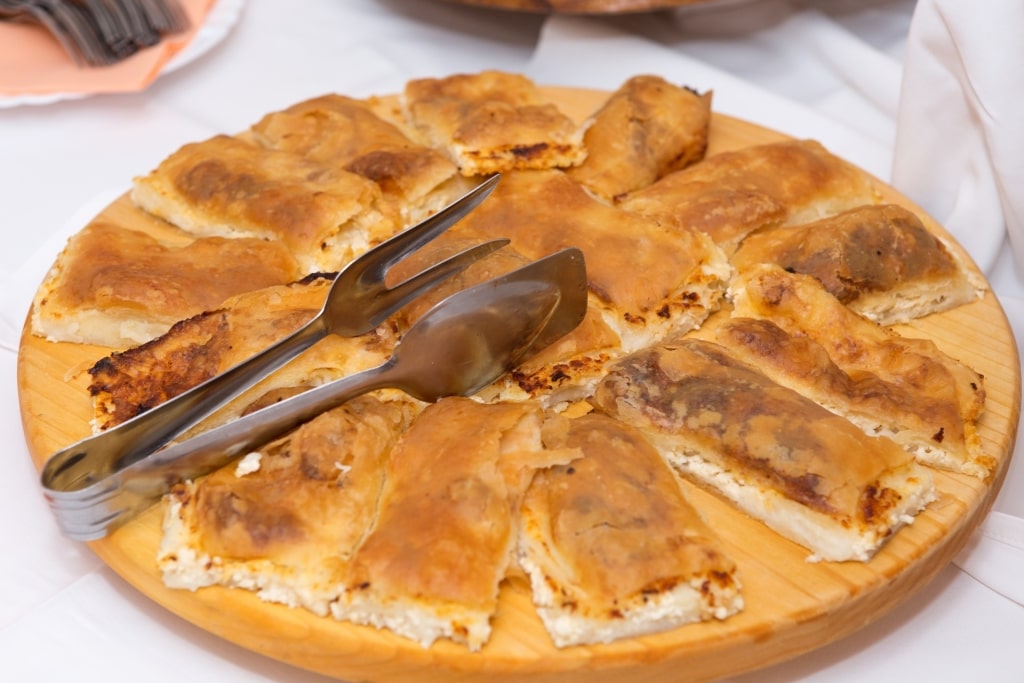
Štrukli
While Štrukli is usually savory, you can also find sweet ones enriched with jam, apples or walnuts. Savory options might include fillings such as spinach, pumpkin, or even diced meat.
Čobanac

Čobanac
Čobanac, meaning “shepherd’s stew”, is a strong and spicy meat stew with potato and onions. It comes from the eastern region of Slavonia, where it was traditionally cooked by shepherds in a cauldron.
The stew mixes at least three types of meat, usually beef, pork, and lamb—but originally featured venison. Warmed up by sweet paprika and hot chili peppers, it’s a hearty winter dish.
Its origin is probably from groups of shepherds sharing what meat they had. Sitting around the fire, they would also add some wine to the pot to help tenderize any tougher cuts.
Čobanac is today made on a large scale for festivals, with an annual competition in Slavonia for the best cook. It’s eaten with thick slices of fresh, homemade bread.
Krafne

Krafne
Krafne are Croatian donuts but without a hole, in Berliner style. They are filled with anything from custard cream to chocolate.
Made from yeast dough, they are deep-fried until golden, then often dusted with powdered sugar. While you can find them in bakeries year-round, they are most common in the carnival season running up to Lent.

Krafne
Krafne are named for chef Cecilia Krapf, who worked for the Austrian-Hungarian Emperor and shared the recipe in 1690. Variants can now be found all over the Balkans, while Naples has a version called Graffe.
The traditional filling is apricot jam, to which a taste of rum can be added. Nowadays, the filling is limited only by the baker’s imagination.
Arancini
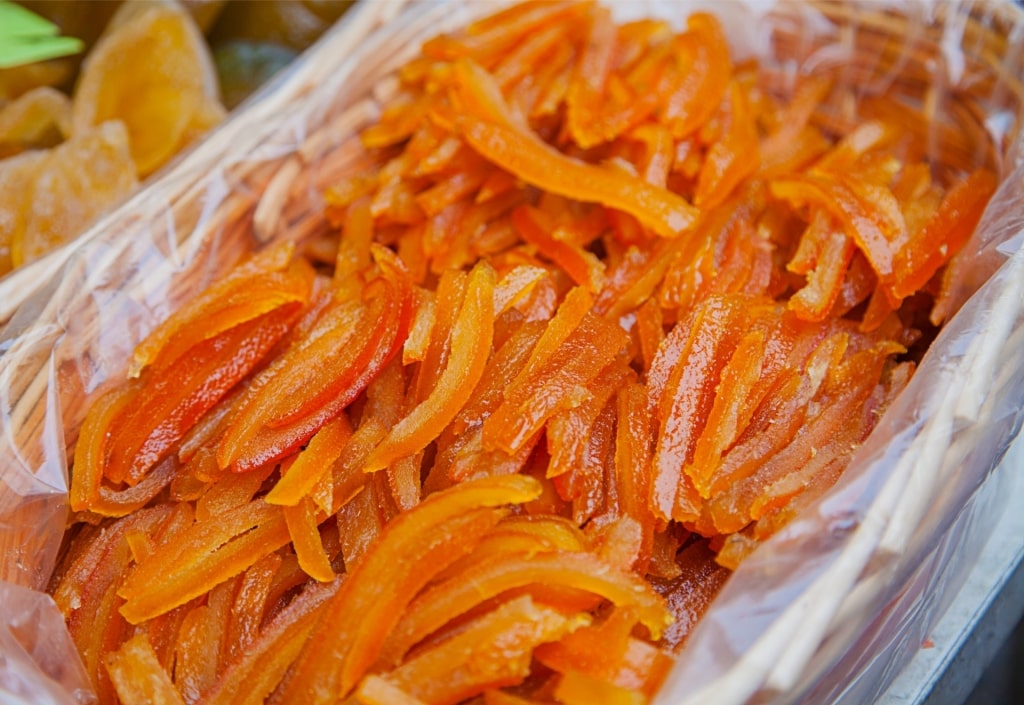
Arancini
Not to be confused with the Italian rice balls, Croatian Arancini are a traditional candied orange peel. The orange is soaked in water to remove any bitterness, then simmered in sugar syrup until it’s translucent.
It’s thought the treats evolved as a way to use up all of an orange—once an expensive luxury. Many families have recipes handed down through generations, with preferences for thin or thick cuts, for example.
Once prepared, the Arancini keep well and are associated with the seasonal festivities of Christmas and Easter. They are often dipped in dark chocolate to make them even tastier.
Grilled Adriatic Fish
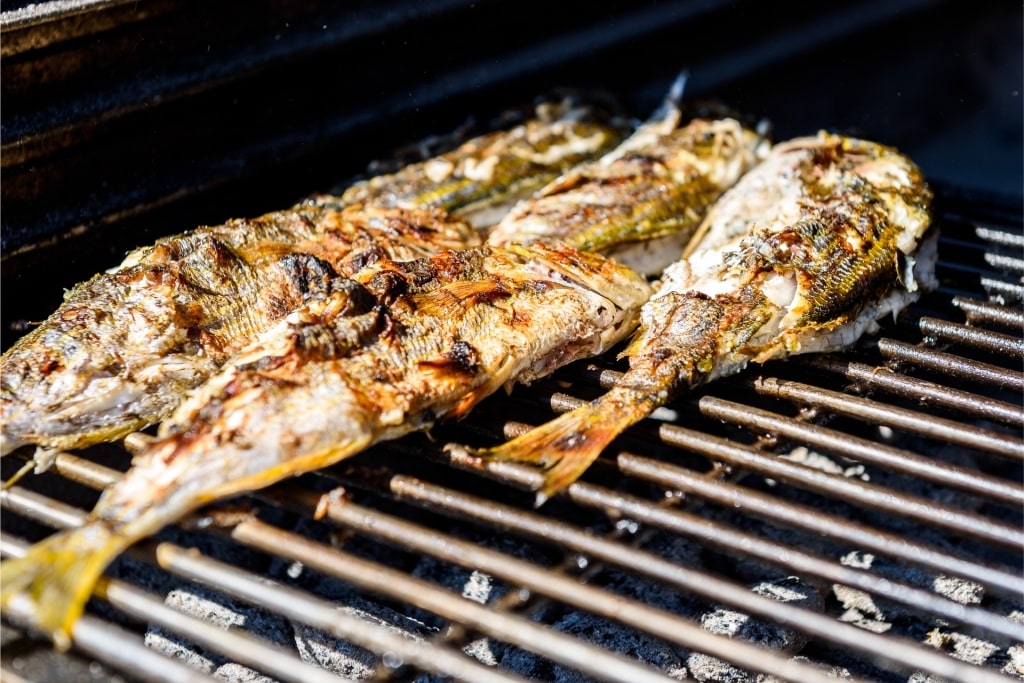
Grilled Adriatic fish
The long Croatian coastline produces an abundance of fish, which is at its best when simply grilled. That’s more difficult than it might seem, with great skill required to keep different species and sizes crisp outside and moist inside.
Fresh fish such as sardines, red mullet, or mackerel are often grilled whole over charcoal or olivewood embers. Seasoning is a simple squeeze of lemon with salt and olive oil.
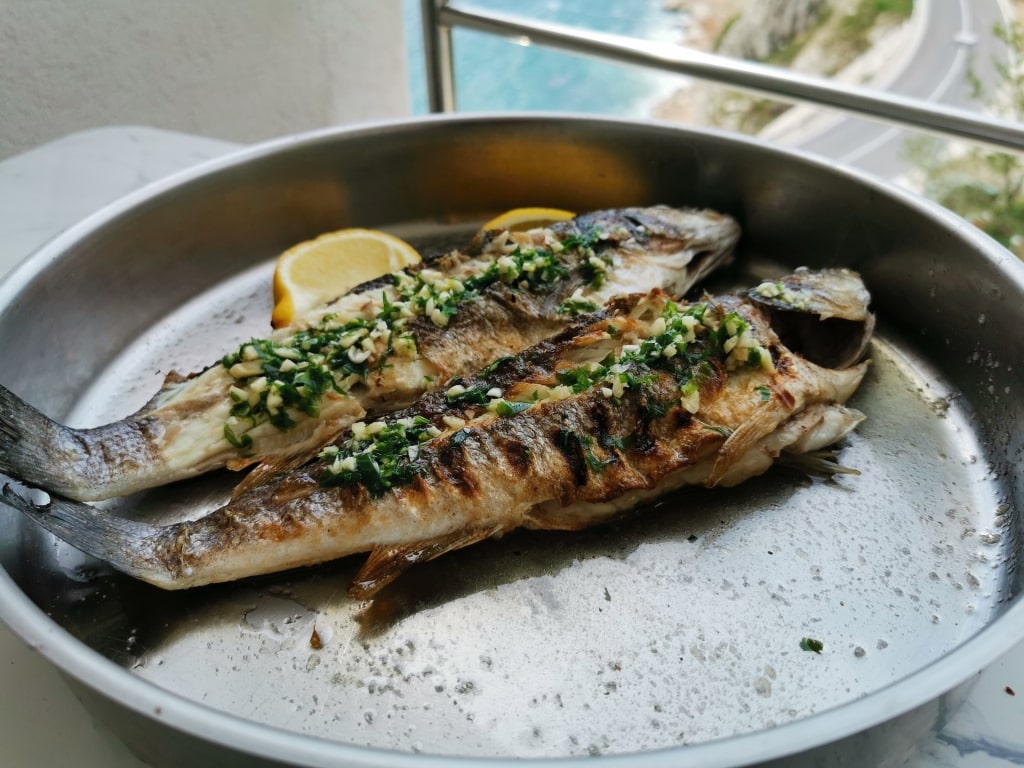
Grilled Adriatic fish
The fish is ideally caught the morning you eat it, and restaurants will show you the day’s catch. Even the sea salt and extra virgin olive oil are carefully chosen for quality.
These simple ingredients produce a memorable highlight of Croatian food, especially if eaten within sight of the Adriatic. Sea bass and bream are among the tastiest fish, while John Dory will be enjoyed by those who dislike bones.
Grah

Grah
Grah is a bean stew that every region of Croatia prides itself on making differently. That may be hard to imagine, given that the basic ingredient is white beans soaked overnight with onions, then cooked very slowly.
However, the addition of smoked meat or sausage to add flavor, or potato to add bulk, is only the start of the variations. Along the coast, olive oil and herbs are added, while recipes favoring lard and paprika dominate further inland.
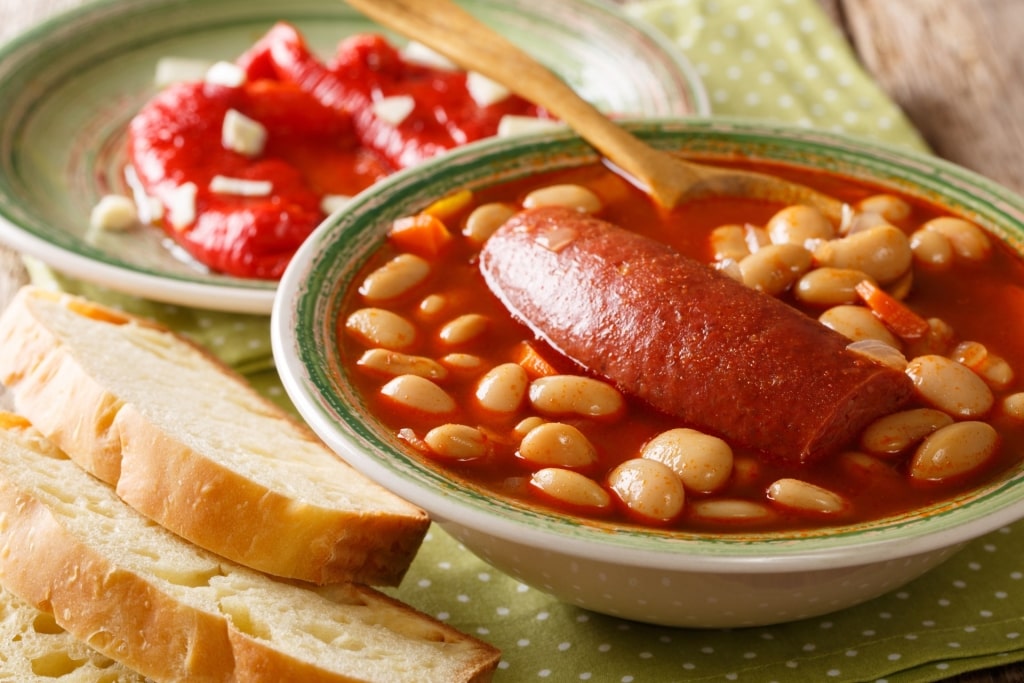
Grah
This is peasant food at its finest: cheap, filling, and nutritious. Grah, which means “beans”, was once the main source of protein for poorer people.
While Croatian food has developed remarkably in recent decades, Grah retains its place as a comfort dish. Eaten with fresh bread and pickled vegetables, it has childhood memories for many Croatians.
Read: Croatia Travel Tips
Arambašići

Arambašići Photo by Argo Navis on Wikimedia Commons, licensed under CC BY-SA 4.0
These cabbage rolls from the Sinj region use diced beef, pork, and mutton, spiced with cinnamon and nutmeg, and wrapped in blanched cabbage leaves. They are then simmered in tomato broth with smoked meats to give them a unique flavor.
Legend has it the sausages celebrate a victory over the Ottomans in 1715. They feature as a headline dish during the annual Sinj Alka knights’ tournament in August.
It’s important that the meat is chopped by hand, and not minced, for better texture and taste. Some recipes add rice to the filling, which purists decry, but they are always better reheated the day after cooking.
The dish has obvious Ottoman origins, with similarities to Turkish sarma wraps. They are served with mashed potatoes and are usually reserved for special occasions.
Makaruli
Makaruli is the Croatian version of macaroni, a tube pasta served usually with a meat ragú. Šporki Makaruli, or “Dirty Macaroni” is a key dish on festive occasions such as Christmas or Dubrovnik’s Saint Blaise celebrations.
The ragú is made by slowly braising a beef shank, cut into chunks. The meat is seasoned with cloves, nutmeg, and cinnamon.
Recipes will then vary but tomatoes, prunes or paprika are all options. The final pasta dish is then served with a generous grating of hard sheep’s cheese.
While the dish has an obvious Italian influence, its name is steeped in Croatian history. The meatless remnants of the sauce were used to “dirty” pasta to serve poor people after a feast.
FAQs
Is Croatia a good food destination?
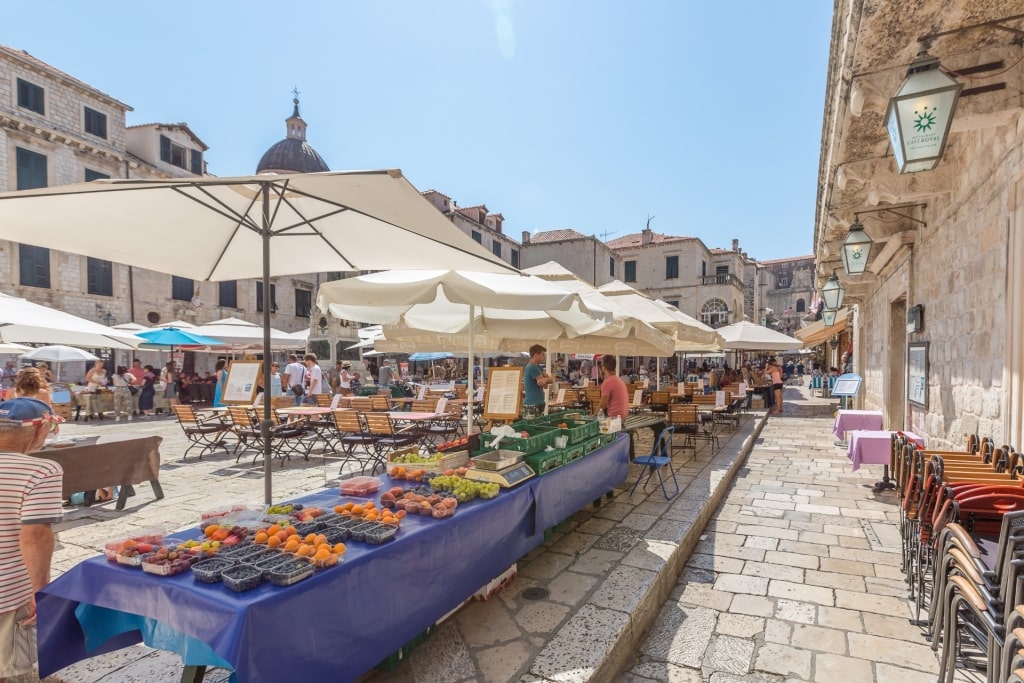
Dubrovnik
Yes, Croatia combines Mediterranean, Central European, and Balkan influences to make a familiar yet surprising cuisine. From fresh seafood on the coast to hearty meat dishes inland, plus excellent wines and olive oil, you have great ingredients and amazing variety.
What dish is Croatia most famous for?
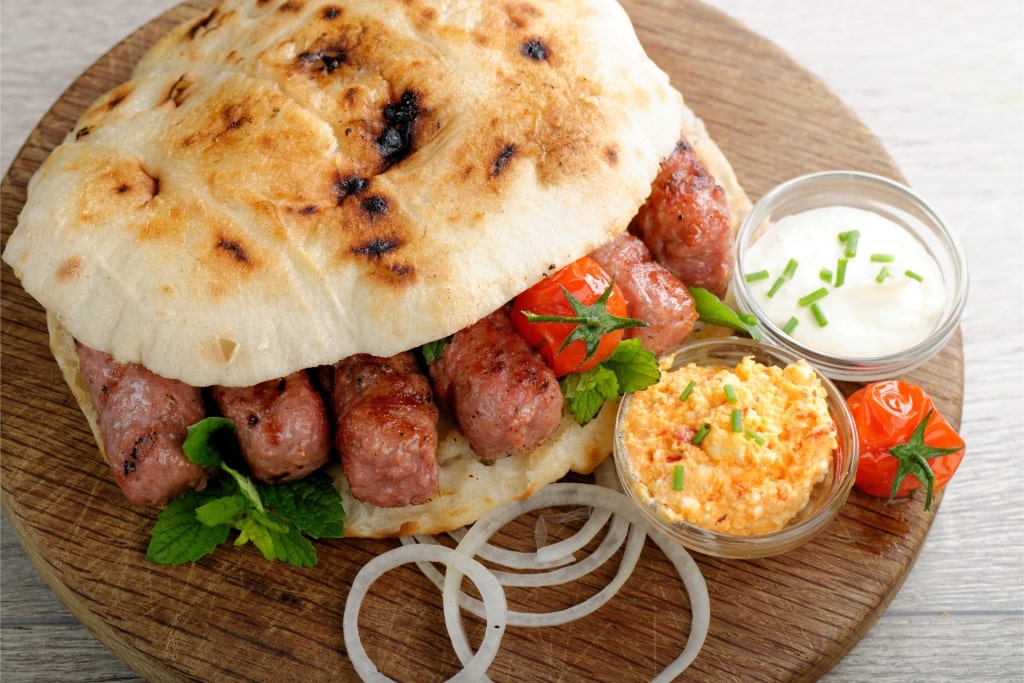
Ćevapi
Different regions of Croatia have different specialties, so it’s hard to identify one stand-out dish. A strong contender would be Ćevapi: grilled meat sausages eaten with bread and onions.
Others would be Peka, a slow-cooked meat and vegetable dish, or Pašticada, a pasta-style dish from Dalmatia. However, the country is more about those regional differences than one national dish.
What time does dinner typically start in Croatia?

Restaurant in Croatia
Dinner starts around 8 p.m., when restaurants and taverns start serving what is often a light meal. The main meal of the day is lunch, usually a multi-course meal eaten between noon and 2 p.m.
Are there any food customs I should know about?
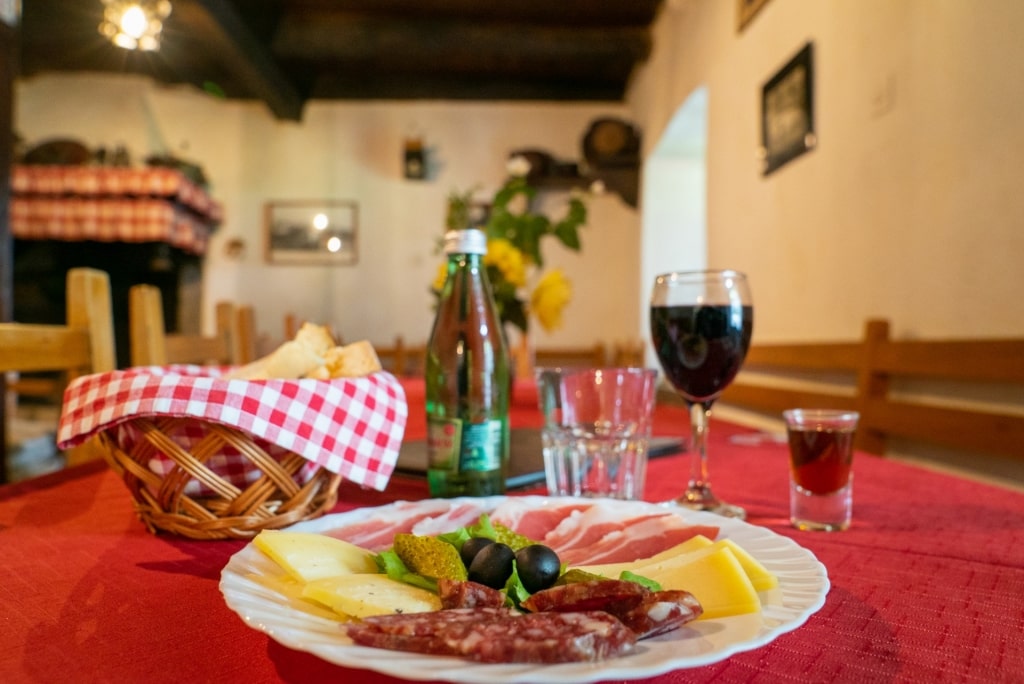
Restaurant in Croatia
Croatians linger over meals, especially lunch, but you also shouldn’t rush through dinner. In traditional konobas—taverns—sharing is common, so large dishes designed to be split are common. Croatians also make their morning coffee last a very long time; ordering coffee to go is highly unusual.
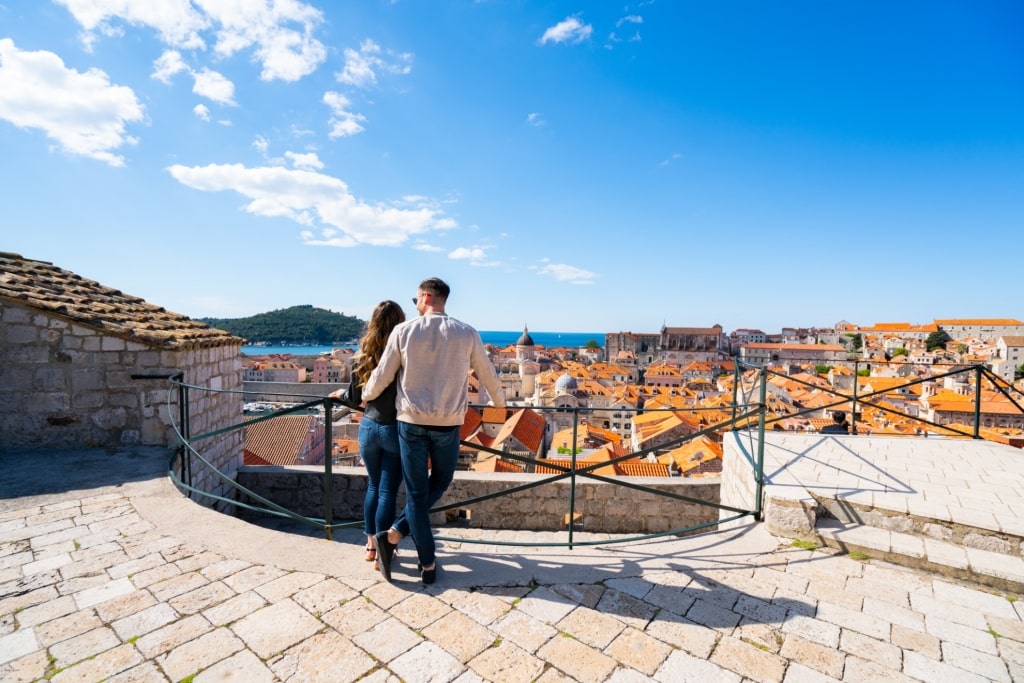
Dubrovnik
Tempted to graze your way from one end of Croatia to another? See the best of the country on a cruise with Celebrity. Browse itineraries on our website to plan your gourmet Croatian cruise vacation.


